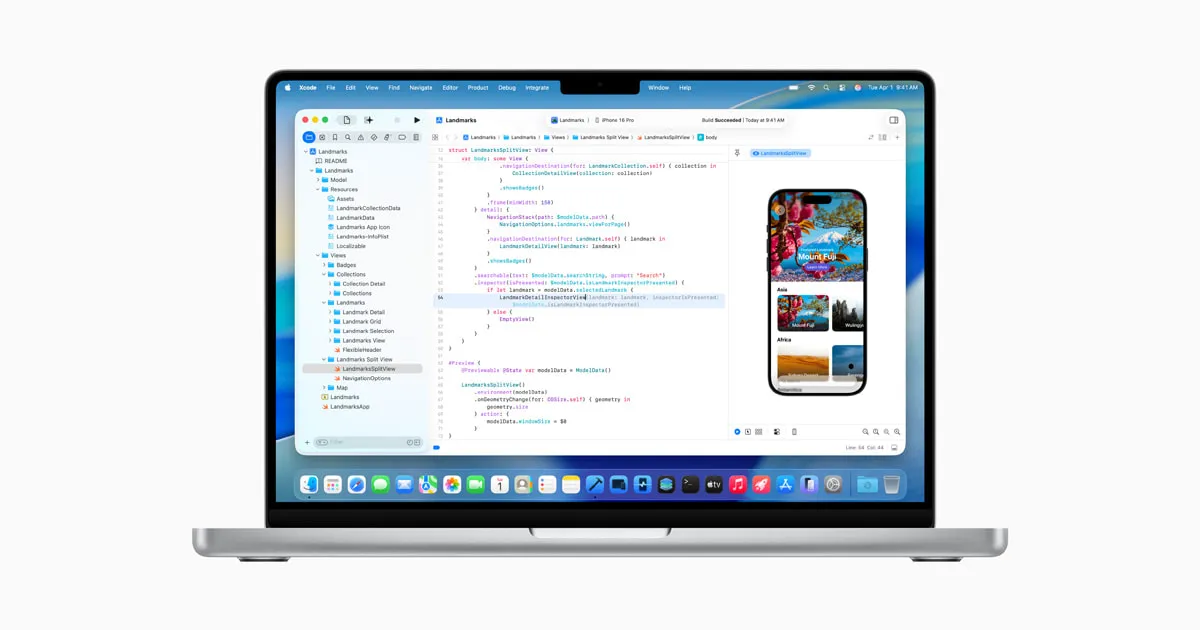
Apple has unveiled a suite of new technologies and enhancements to its developer tools, aimed at fostering creativity, innovation, and design across its platforms. These advancements provide developers with everything they need to create stunning, modern applications with speed and confidence. Announced in Cupertino, California, these updates are set to transform the app development landscape across iOS 26, iPadOS 26, macOS Tahoe 26, watchOS 26, and tvOS 26.
The latest software design emphasizes content focus and delivers expressive experiences that remain familiar to users. The integration of the Foundation Models framework allows developers to tap into on-device intelligence, enhancing user interactions significantly. Additionally, Xcode 26 now incorporates large language models like ChatGPT, equipping developers with Xcode’s Coding Tools and other intelligent features. These new resources complement Apple’s extensive offering of over 250,000 APIs, which enable seamless integration with Apple’s hardware and software capabilities.
“Developers play a vital role in shaping the experiences customers love across Apple platforms,” stated Susan Prescott, Apple’s vice president of Worldwide Developer Relations. “With access to the on-device Apple Intelligence foundation model and new intelligence features in Xcode 26, we’re empowering developers to build richer, more intuitive apps for users everywhere.”
The elegant design introduced in this update employs a new software-based material known as Liquid Glass. This material blends the optical qualities of glass with fluidity, allowing developers to create more expressive and delightful apps. From buttons to tab bars, Liquid Glass enhances user interaction by maintaining a cohesive design language across Apple platforms. Native frameworks like SwiftUI provide the necessary tools for developers to seamlessly adopt this new design in their applications.
Moreover, the new Icon Composer app empowers developers to craft visually captivating icons, ensuring a consistent visual identity for their apps. This tool supports multiple rendering modes, offering advanced features like blurring and translucency adjustments.
The Foundation Models framework enables developers to build intelligent applications that work offline and prioritize user privacy. With native support for Swift, developers can access the Apple Intelligence model with minimal code. Features such as guided generation and tool calling simplify the implementation of generative capabilities in existing applications. For instance, Automattic is utilizing this framework in its Day One journaling app to integrate privacy-centric intelligence features.
“The Foundation Model framework has helped us rethink what’s possible with journaling,” said Paul Mayne, head of Day One at Automattic. “Now we can bring intelligence and privacy together in ways that deeply respect our users.”
Xcode 26 is packed with features designed to enhance productivity and streamline the coding process. Developers can now connect large language models directly into their workflow to write code, tests, and documentation efficiently. With built-in support for ChatGPT, developers have the flexibility to utilize API keys from various providers or run local models on their Macs.
Additionally, Coding Tools offer suggested actions from anywhere in the code, helping developers generate previews and fix issues inline. Xcode 26 also introduces a redesigned navigation experience, improved localization catalog, and enhanced support for Voice Control, allowing developers to navigate and dictate Swift code entirely by voice.
App Intents enhances app integration across Apple platforms, including Siri and Spotlight. This year, it gains support for visual intelligence, enabling applications to provide visual search results that lead users directly into the app. For example, Etsy is leveraging this feature to improve user experience by facilitating faster discovery of products.
“At Etsy, our job is to seamlessly connect shoppers with creative entrepreneurs around the world,” said Etsy CTO Rafe Colburn. “The ability to meet shoppers right on their iPhone with visual intelligence is a meaningful unlock.”
Swift 6.2 introduces advanced features to improve performance and interoperability with languages like C++, Java, and JavaScript, while also gaining support for WebAssembly. These enhancements simplify the coding process, allowing developers to configure modules to run on the main actor by default, thus reducing the need for additional annotations.
The new Containerization framework allows developers to create and run Linux container images directly on Mac, providing secure isolation between images. This framework is optimized for Apple silicon, enhancing overall development security.
Apple is also providing developers with the Game Porting Toolkit 3 and Metal 4, designed for advanced graphics and machine learning technologies. Developers can benefit from tools that optimize graphics code for better performance, create immersive gaming experiences, and streamline game development workflows on Mac.
To promote child safety, developers can utilize tools such as parental controls and the Sensitive Content Analysis framework. The new Declared Age Range API allows developers to deliver age-appropriate content while respecting user privacy by enabling parents to share their children’s age range without disclosing sensitive information.
Apple is enhancing the App Store with Accessibility Nutrition Labels that inform users about supported accessibility features before downloading an app. Developers can now provide detailed information regarding their app’s support for features like VoiceOver and Voice Control, ensuring a more inclusive experience for all users.
These updates join Apple’s ever-expanding collection of developer tools and technologies, which are available for testing now through the Apple Developer Program. A public beta will be available next month through the Apple Beta Software Program. For more information about these updates and their availability, please visit apple.com/apple-intelligence.
Apple continues to push the boundaries of technology and innovation, providing developers with powerful tools to create transformative user experiences across its platforms.